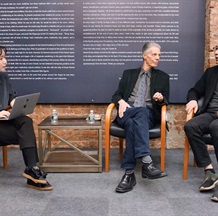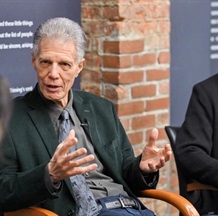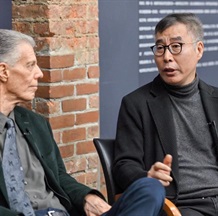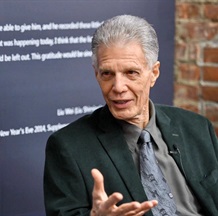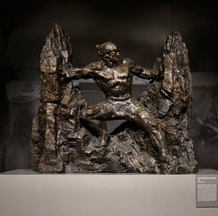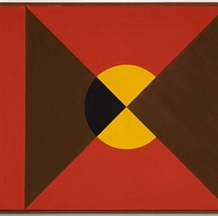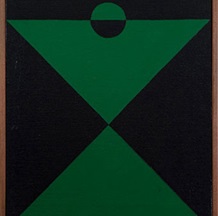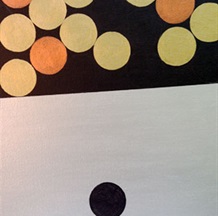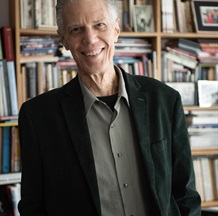Interview with Professor Robert C. Morgan
Date:
2020.02.08
As a writer, artist, critic and art historian, Professor Robert C. Morgan has a background in the history and aesthetics of both Western and Asian art. He also works as a curator and educator focusing on international artists and exhibitions. As an art critic, Morgan currently writes for The Brooklyn Rail and Whitehot Magazine in New York and, from 2014 – 19, was the New York Editor for Asian Art News. In 1999, he was given the Arcale award in Salamance (Spain) for his work as an International Art Critic.
On the occasion of the exhibition “Departure and Return: Liu Shiming’s Sculpture” at the Asian Art Center New York, Professor Morgan was invited to attend the opening reception. Two weeks following, CAFA ART INFO arranged an interview in which Professor Morgan spoke about Liu’s sculpture, focusing on the artist’s spiritual understanding and aesthetic dimensions.
The beginning of the interview between Professor Morgan and CAFA ART INFO started with a discussion of Liu Shiming’s sculptural language. This included comments on the technique referred to as “kneading.” This further developed into comments related to the work’s significance relative to Liu Shiming’s exhibition in the U.S. that included the Professor Morgan’s interest in the artist’s philosophy as an artist.
CAFA ART INFO: Good Morning, Professor Morgan. Thank you for your time. I believe you had the opportunity to view the exhibition of Liu Shiming two weeks ago. Was this the first occasion for you to experience his art directly?
Morgan: Yes, I received an invitation to come here (Asian Art Center New York) for the exhibition opening. I was not sure who gave them my name, but it was a generous invitation. I read about Liu Shiming and that interested me. So I decided to come.
CAFA ART INFO: So after viewing Mr. Liu Shiming’s exhibition, how do you understand and comment on his works in terms of his sculptural language? I learned that you have a sculptural background.
Morgan: Yes, I do. I received my MFA in Sculpture. I have been a Contributing Editor to Sculpture Magazine, and now I am the New York editor for World Sculpture News. Regarding Liu Shiming’s sculpture from a historical, cultural, and sociological perspective, I was interested in the fact that much of the work was done during the 1960s and 70s. This was a subject I wanted to explore further. I was interested in the forms and the subject matter he was using. I think these were really within the context of Chinese folk art.
I am interested in the survival of Chinese folk art. I see the previous time in which he worked as the beginning of a rejuvenation of the historical past. I am aware of the fact that the twentieth-century was not and easy time for China. I think that Westerners, given their own history, often overlook this fact. But if you are aware of the history of China in the twentieth century, it was a challenging and difficult period. I mention this because art is very much a part of history. It is an important part of the culture, and in the struggle to find a new way. Those who were artists had to discover new ways to conduct themselves in order to function as artists. I have a great deal of admiration and respect for Liu Shiming.
CAFA ART INFO: Mr. Liu Shiming created many of his works based on the technique "kneading," while he absorbed and developed this technique from his working experience of artifacts repairing and replicating in the National Museum of China. This traditional Chinese sculptural technique stands in contrast to the emphasis on carving and molding in the Western sculptural tradition. How do you comprehend his classical Chinese technique from your perspective?
Morgan: What I see in Liu Shiming’s work is a very personal, intimate point of view. He is dealing with his family, people and animals that are within his realm, in his village, which is a humbling experience. I think this is the distinguishing characteristic in his work. Honestly, I think his humanity as an artist is very positive in terms of how he brought these subjects to the foreground of our attention.
I am not quite certain as to why so much attention is given to what you call “kneading” in his work. Let me explain how I understand that. While kneading clay is certainly an Asian way of working, particularly in the outlying villages away from urban centers, it is also a technique used by sculptors in the West. But it is used differently. In the West, it is most often found in the preparation stage whereby the artist creates a model, which will later be cast either in bronze or aluminum. But when you are dealing with folk art in the villages of China, the idea of casting in bronze or aluminum is not present because the material is not easily available, certainly not during that time period. The methods are very different in the West from the Chinese point of view. The technique of “kneading” in China is not only the beginning stage, but it is also the finishing stage. This is because the role of Chinese sculptor gives the manipulation of clay an expressive quality. The way the clay is handled by Liu is about discovering this expressive quality in the process of the work. This does not mean that his point of view is Expressionism, which is primarily associated with Western art in the early and middle twentieth century. For Liu, he is more concerned with something very personal and intimate. He is interested that the way the clay is manipulated or kneaded will reveal a distinctly personal feeling. You can do kneading with numerous ways, but I think kneading for Liu Shiming was a method bound directly to the clay. His physical and emotional connection with the materiality of clay was intended to evolve into something significant for him. The works he created are very much about village life and his everyday experiences. I think his work is totally involved with conveying the intimacy of these experiences through sculpture.
CAFA ART INFO: I have talked to an Italian sculptor a few days ago about the use of clay in Liu Shiming’s sculpture. He was also aware of the fact that Liu did not utilize clay in a preparation stage as the Marquette for future work. Instead, those clay or pottery sculptures are the finished-version for Liu Shiming. He did not intend to transform it into another material such as bronze or aluminum.
Morgan: I would say what I saw in the exhibition here was what he wanted his sculpture to be. I think we really have to think in terms of Chinese folk art because that is essentially what he is doing. This idea needs to be respected and understood. There is a message in his work just as there is in any other artist’s work. His art carries a very specific message in relation to village life and to the kind of humble presence indicative of that life. He was really giving us a narrative about living in Chinese villages at the time he worked, but it was also a theme that had continued for centuries in China. I think it was probably more challenging during the 1960s and 70s because of the governmental changes and policies beyond the artist’s control that required him to conform to a certain schedule and way of working.
As you know, in addition to his folk art, Liu was also introduced to socialist realism. I remember in the exhibition there is one of a large work against the wall where we saw a figure tearing down a wall (Cutting Through Mountains to Bring in Water, CN. 劈山引水, 1959). It was a very masculine-looking figure. Then I realized that there were no genitalia on the figure even though he appeared very strong and masculine. Most likely, the figure had to be represented in this way or it would have been difficult to show in a public exhibition.
CAFA ART INFO: Can you share your ideas regarding the influences and significance to the West in terms of holding Liu Shiming’s exhibition in New York and Washington D.C.?
Morgan: I think Washington is a great location for this. As I mentioned earlier, I think that Americans are not familiar with the kind of life that Liu Shiming was living as an artist. What we are seen here in the New York galleries and museums over the last two decades is more avant-garde Chinese art or antiquity going back for centuries. But I do not think there has been a great deal of information or knowledge related to Chinese folk art.
Liu Shiming offers a point of view that at this moment is very important, because his work introduces what has been missing. I think he is a superb artist in that he gives folk-art an important status that brings a way of life into the consciousness of American viewers. His figures reveal the kind of life he was living and expresses it in a highly personal way through the medium of clay.
CAFA ART INFO: Viewing Liu’s work in a contemporary context, do you see there is a kind of “modernity”1 behind Liu’s works?
Morgan: Not really. Liu was not working within a modernist tradition. Even so, he has some feeling for abstract form, which some observers might consider modern. Even so, I do not know how far that can go in terms of influence. Its really more about his work having an affinity with modernity, which is a way of life that falls short of aligning his art with modernism. In either case, I am not sure how important any of this was for Liu. I would rather emphasize what I see as his fundamental role as an artist expressing himself within the context of everyday life through the materials and the methods available to him. Given the period of history in which he lived, the value of this pursuit cannot and should be underestimated. It is a statement on the human condition in China that most Americans simply do not know, and yet, perhaps need to know.
CAFA ART INFO: My last question is about you as an artist. I have viewed some of your early artworks online. You have created a series of abstract paintings and installations. In your personal statement, you mentioned that you are influenced by Tao Te Ching. I wonder what attracted you to explore Chinese philosophy in-depth compared to western philosophy?
Morgan: Yes, I have a copy of the Tao Te Ching right here. I was introduced to it by a friend many years ago. Since then, I have spent many hours reading it over and over. I became interested in the absence of duality. The focus was on the path or the Way. This is the meaning of Tao, and the fact that the Way was not a single Way, but a multiplicity of possible universes that could exist within the Way. It is so different than the kind of ideas taught by Western philosophers from the eighteenth and nineteen centuries. This would include such figures as Kant, Hegel, Kierkegaard and Nietzsche among others. While they are all important to me, the Tao Te Ching gave another point of view very different from theirs. For example, I can read one passage from chapter 48.
I am reading this in the English translation. Even so, I think it offers an important point of view that can help Westerners know and understand themselves better.
“In the pursuit of knowledge, everyday something is added. In the practice of the Tao, everyday something is dropped. Less and less do you need to force things, until finally you arrive at non-action. When nothing is done, nothing is left undone. True mastery can be gained by letting things go their own way. It cannot be gained by interfering.”
This is so beautifully and exquisitely non-Western, but nonetheless an important concept for Western people to understand. Our society must change and become more focused. This is how I have felt for the last forty-five years. This has stayed with me and it still stays with me. I am still reading the Tao Te Ching and still refer to it when I am painting.
CAFA ART INFO: That’s insightful. I think I would read Tao Te Ching again. I read the Chinese version maybe five years ago, but at that time I feel like I did not get a lot from it. And it is interesting to notice when you read the paragraph in English just now, I could not fully connect the corresponding Chinese phrases. I think it has something to do with the cultural differences in translation.
Morgan: Yes there are many translations I have read, and they are not all the same. I picked this one up because I agree with it. When it talks about the master, it talks in a feminism voice, which I think it is interesting. It is very timely for the present.
Translators Notes:
1. Here the interviewer phrased like this as she read the curator’s forward, which stated that artists like Liu Shiming were rooted in the modern transformation of Chinese traditional contexts and local experiences. In the Chinese scholar’s perspective, Liu contributed to the modernization of Chinese sculpture that has taken place in the last one hundred years. At that time, he was a pioneer as he diverged himself from the Western narrative of modernity at the time when most Chinese artists were learning from the West.
After sorting out the interview, the interviewer was questioning the accuracy of using the English term “modernity” in this context to describe a certain period of China or an artist’s avant-garde contribution in China’s 20th century. Also, its associated word “modernism” acts as a significant component in Western art history.
Obviously, Liu’s choice and art provided sculptors in his time with a sort of insight in terms of looking back to Chinese tradition and making traditional culture more “contemporary. ” So when the interviewer says “modernity” here, she is actually trying to explore the insight of Liu’s work from the perspective of the contemporary art world on the development of current and future art.
Interview conducted by Emily Weimeng Zhou
Interviewee: Professor Robert C. Morgan, Mr. Liu Wei
Edited by Professor Robert C. Morgan and Sue/CAFA ART INFO
View of the interview and the exhibition courtesy of the Asian Cultural Center, New York
Portrait of Robert C. Morgan photographed by Sebastian Piras
View of artworks courtesy of interviewees
On the occasion of the exhibition “Departure and Return: Liu Shiming’s Sculpture” at the Asian Art Center New York, Professor Morgan was invited to attend the opening reception. Two weeks following, CAFA ART INFO arranged an interview in which Professor Morgan spoke about Liu’s sculpture, focusing on the artist’s spiritual understanding and aesthetic dimensions.
The beginning of the interview between Professor Morgan and CAFA ART INFO started with a discussion of Liu Shiming’s sculptural language. This included comments on the technique referred to as “kneading.” This further developed into comments related to the work’s significance relative to Liu Shiming’s exhibition in the U.S. that included the Professor Morgan’s interest in the artist’s philosophy as an artist.
CAFA ART INFO: Good Morning, Professor Morgan. Thank you for your time. I believe you had the opportunity to view the exhibition of Liu Shiming two weeks ago. Was this the first occasion for you to experience his art directly?
Morgan: Yes, I received an invitation to come here (Asian Art Center New York) for the exhibition opening. I was not sure who gave them my name, but it was a generous invitation. I read about Liu Shiming and that interested me. So I decided to come.
CAFA ART INFO: So after viewing Mr. Liu Shiming’s exhibition, how do you understand and comment on his works in terms of his sculptural language? I learned that you have a sculptural background.
Morgan: Yes, I do. I received my MFA in Sculpture. I have been a Contributing Editor to Sculpture Magazine, and now I am the New York editor for World Sculpture News. Regarding Liu Shiming’s sculpture from a historical, cultural, and sociological perspective, I was interested in the fact that much of the work was done during the 1960s and 70s. This was a subject I wanted to explore further. I was interested in the forms and the subject matter he was using. I think these were really within the context of Chinese folk art.
I am interested in the survival of Chinese folk art. I see the previous time in which he worked as the beginning of a rejuvenation of the historical past. I am aware of the fact that the twentieth-century was not and easy time for China. I think that Westerners, given their own history, often overlook this fact. But if you are aware of the history of China in the twentieth century, it was a challenging and difficult period. I mention this because art is very much a part of history. It is an important part of the culture, and in the struggle to find a new way. Those who were artists had to discover new ways to conduct themselves in order to function as artists. I have a great deal of admiration and respect for Liu Shiming.
CAFA ART INFO: Mr. Liu Shiming created many of his works based on the technique "kneading," while he absorbed and developed this technique from his working experience of artifacts repairing and replicating in the National Museum of China. This traditional Chinese sculptural technique stands in contrast to the emphasis on carving and molding in the Western sculptural tradition. How do you comprehend his classical Chinese technique from your perspective?
Morgan: What I see in Liu Shiming’s work is a very personal, intimate point of view. He is dealing with his family, people and animals that are within his realm, in his village, which is a humbling experience. I think this is the distinguishing characteristic in his work. Honestly, I think his humanity as an artist is very positive in terms of how he brought these subjects to the foreground of our attention.
I am not quite certain as to why so much attention is given to what you call “kneading” in his work. Let me explain how I understand that. While kneading clay is certainly an Asian way of working, particularly in the outlying villages away from urban centers, it is also a technique used by sculptors in the West. But it is used differently. In the West, it is most often found in the preparation stage whereby the artist creates a model, which will later be cast either in bronze or aluminum. But when you are dealing with folk art in the villages of China, the idea of casting in bronze or aluminum is not present because the material is not easily available, certainly not during that time period. The methods are very different in the West from the Chinese point of view. The technique of “kneading” in China is not only the beginning stage, but it is also the finishing stage. This is because the role of Chinese sculptor gives the manipulation of clay an expressive quality. The way the clay is handled by Liu is about discovering this expressive quality in the process of the work. This does not mean that his point of view is Expressionism, which is primarily associated with Western art in the early and middle twentieth century. For Liu, he is more concerned with something very personal and intimate. He is interested that the way the clay is manipulated or kneaded will reveal a distinctly personal feeling. You can do kneading with numerous ways, but I think kneading for Liu Shiming was a method bound directly to the clay. His physical and emotional connection with the materiality of clay was intended to evolve into something significant for him. The works he created are very much about village life and his everyday experiences. I think his work is totally involved with conveying the intimacy of these experiences through sculpture.
CAFA ART INFO: I have talked to an Italian sculptor a few days ago about the use of clay in Liu Shiming’s sculpture. He was also aware of the fact that Liu did not utilize clay in a preparation stage as the Marquette for future work. Instead, those clay or pottery sculptures are the finished-version for Liu Shiming. He did not intend to transform it into another material such as bronze or aluminum.
Morgan: I would say what I saw in the exhibition here was what he wanted his sculpture to be. I think we really have to think in terms of Chinese folk art because that is essentially what he is doing. This idea needs to be respected and understood. There is a message in his work just as there is in any other artist’s work. His art carries a very specific message in relation to village life and to the kind of humble presence indicative of that life. He was really giving us a narrative about living in Chinese villages at the time he worked, but it was also a theme that had continued for centuries in China. I think it was probably more challenging during the 1960s and 70s because of the governmental changes and policies beyond the artist’s control that required him to conform to a certain schedule and way of working.
As you know, in addition to his folk art, Liu was also introduced to socialist realism. I remember in the exhibition there is one of a large work against the wall where we saw a figure tearing down a wall (Cutting Through Mountains to Bring in Water, CN. 劈山引水, 1959). It was a very masculine-looking figure. Then I realized that there were no genitalia on the figure even though he appeared very strong and masculine. Most likely, the figure had to be represented in this way or it would have been difficult to show in a public exhibition.
CAFA ART INFO: Can you share your ideas regarding the influences and significance to the West in terms of holding Liu Shiming’s exhibition in New York and Washington D.C.?
Morgan: I think Washington is a great location for this. As I mentioned earlier, I think that Americans are not familiar with the kind of life that Liu Shiming was living as an artist. What we are seen here in the New York galleries and museums over the last two decades is more avant-garde Chinese art or antiquity going back for centuries. But I do not think there has been a great deal of information or knowledge related to Chinese folk art.
Liu Shiming offers a point of view that at this moment is very important, because his work introduces what has been missing. I think he is a superb artist in that he gives folk-art an important status that brings a way of life into the consciousness of American viewers. His figures reveal the kind of life he was living and expresses it in a highly personal way through the medium of clay.
CAFA ART INFO: Viewing Liu’s work in a contemporary context, do you see there is a kind of “modernity”1 behind Liu’s works?
Morgan: Not really. Liu was not working within a modernist tradition. Even so, he has some feeling for abstract form, which some observers might consider modern. Even so, I do not know how far that can go in terms of influence. Its really more about his work having an affinity with modernity, which is a way of life that falls short of aligning his art with modernism. In either case, I am not sure how important any of this was for Liu. I would rather emphasize what I see as his fundamental role as an artist expressing himself within the context of everyday life through the materials and the methods available to him. Given the period of history in which he lived, the value of this pursuit cannot and should be underestimated. It is a statement on the human condition in China that most Americans simply do not know, and yet, perhaps need to know.
CAFA ART INFO: My last question is about you as an artist. I have viewed some of your early artworks online. You have created a series of abstract paintings and installations. In your personal statement, you mentioned that you are influenced by Tao Te Ching. I wonder what attracted you to explore Chinese philosophy in-depth compared to western philosophy?
Morgan: Yes, I have a copy of the Tao Te Ching right here. I was introduced to it by a friend many years ago. Since then, I have spent many hours reading it over and over. I became interested in the absence of duality. The focus was on the path or the Way. This is the meaning of Tao, and the fact that the Way was not a single Way, but a multiplicity of possible universes that could exist within the Way. It is so different than the kind of ideas taught by Western philosophers from the eighteenth and nineteen centuries. This would include such figures as Kant, Hegel, Kierkegaard and Nietzsche among others. While they are all important to me, the Tao Te Ching gave another point of view very different from theirs. For example, I can read one passage from chapter 48.
I am reading this in the English translation. Even so, I think it offers an important point of view that can help Westerners know and understand themselves better.
“In the pursuit of knowledge, everyday something is added. In the practice of the Tao, everyday something is dropped. Less and less do you need to force things, until finally you arrive at non-action. When nothing is done, nothing is left undone. True mastery can be gained by letting things go their own way. It cannot be gained by interfering.”
This is so beautifully and exquisitely non-Western, but nonetheless an important concept for Western people to understand. Our society must change and become more focused. This is how I have felt for the last forty-five years. This has stayed with me and it still stays with me. I am still reading the Tao Te Ching and still refer to it when I am painting.
CAFA ART INFO: That’s insightful. I think I would read Tao Te Ching again. I read the Chinese version maybe five years ago, but at that time I feel like I did not get a lot from it. And it is interesting to notice when you read the paragraph in English just now, I could not fully connect the corresponding Chinese phrases. I think it has something to do with the cultural differences in translation.
Morgan: Yes there are many translations I have read, and they are not all the same. I picked this one up because I agree with it. When it talks about the master, it talks in a feminism voice, which I think it is interesting. It is very timely for the present.
Translators Notes:
1. Here the interviewer phrased like this as she read the curator’s forward, which stated that artists like Liu Shiming were rooted in the modern transformation of Chinese traditional contexts and local experiences. In the Chinese scholar’s perspective, Liu contributed to the modernization of Chinese sculpture that has taken place in the last one hundred years. At that time, he was a pioneer as he diverged himself from the Western narrative of modernity at the time when most Chinese artists were learning from the West.
After sorting out the interview, the interviewer was questioning the accuracy of using the English term “modernity” in this context to describe a certain period of China or an artist’s avant-garde contribution in China’s 20th century. Also, its associated word “modernism” acts as a significant component in Western art history.
Obviously, Liu’s choice and art provided sculptors in his time with a sort of insight in terms of looking back to Chinese tradition and making traditional culture more “contemporary. ” So when the interviewer says “modernity” here, she is actually trying to explore the insight of Liu’s work from the perspective of the contemporary art world on the development of current and future art.
Interview conducted by Emily Weimeng Zhou
Interviewee: Professor Robert C. Morgan, Mr. Liu Wei
Edited by Professor Robert C. Morgan and Sue/CAFA ART INFO
View of the interview and the exhibition courtesy of the Asian Cultural Center, New York
Portrait of Robert C. Morgan photographed by Sebastian Piras
View of artworks courtesy of interviewees


